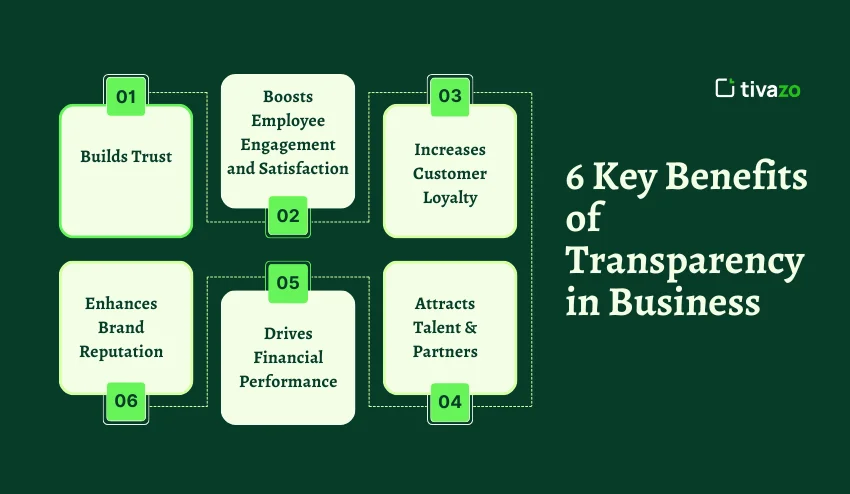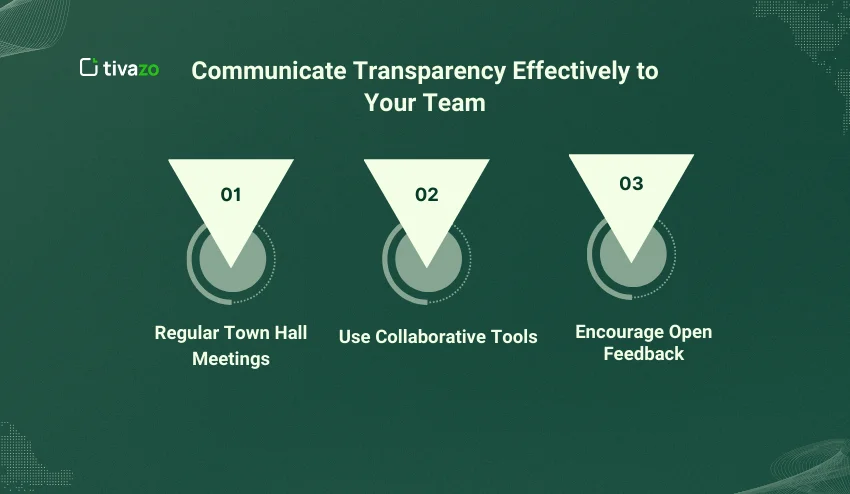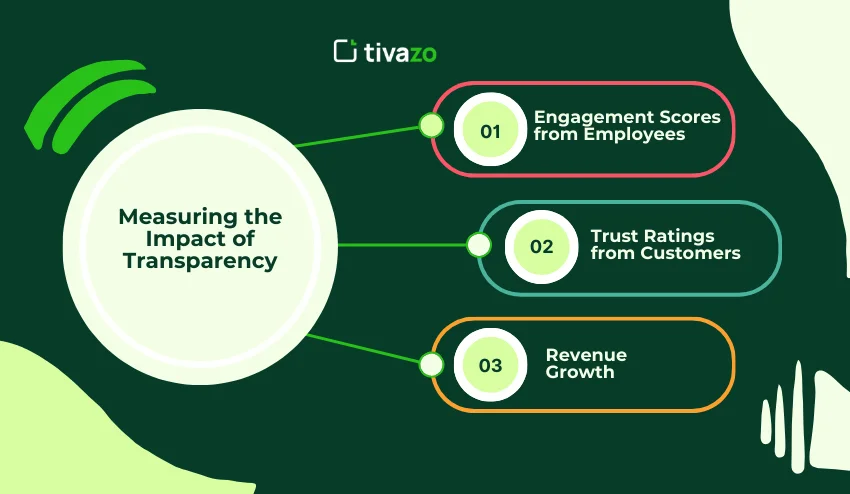In the current dynamic economy and workplace setting, transparency is a rarely talked about but serious game-changer. Transparency is no longer simply a trending term in a company culture or a “nice-to-have” element; it’s an advantage over your competition and industry peers. When companies build and foster transparency within their organizational culture, they create trustworthiness, elevate their brand image, and generate an environment in which employees are engaged, customers are loyal, and profits are maximized.
Are you prepared to jump into a more transparent business model? In this blog, I want to highlight why transparency is a significant aspect of success, and how your company can develop and use transparent practices to inspire growth.
Key Highlights:
- What does transparency mean in business
- Why Businesses Should Embrace Transparency
- Benefits of Transparency in Business
- How to Communicate Transparency Effectively to Your Team
- Role of Technology in Enhancing Transparency in Business
- Measuring the Impact of Transparency
What does transparency in business mean?
Transparency means being open, honest, and accountable in everything you do in your business, whether with employees, customers, or stakeholders. It’s about informing key stakeholders in order to allow them to make informed decisions.
Transparency is more than just sharing finances, even though that’s one part of it. Transparency is the idea of effective communication at all levels of the organization. It entails a certain level of disclosure around things like company objectives, how decisions are made, operational plans, and even mistakes. It just means saying, “This is what we’re doing; this is why we’re doing it.”
Why Businesses Should Embrace Transparency (And How It Drives Success)
There is a moral appeal to being transparent, but there are also financial implications associated with transparency in business, with businesses having a built-in financial incentive to be transparent.
Research from Deloitte shows that organizations that rank in the 90th percentile for employee experience are 25% more profitable than organizations that are in the 10th percentile for employee experience. It’s not surprising. When employees trust their leaders and are part of the decision-making process, they are more engaged, more productive, and less likely to leave the organization.
6 Key Benefits of Transparency in Business
6 Key Benefits of Transparency in Business are as follows:

1. Builds Trust (Internal & External)
Transparency in business creates trust, and trust is invaluable. When your business is transparent, you are indicating that you have nothing to hide. This helps to strengthen internal relationships with your team while also cultivating external trust with your customers and stakeholders. In a world of skepticism, transparency is the ultimate instigator of trust.
- Internal Trust: Employees are more likely to stay with a company when they feel trusted and valued. They are also more likely to collaborate and share ideas, which are important elements of a healthy workplace culture.
- External Trust: Customers and partners appreciate businesses that are transparent about their practices, whether that be pricing, sustainability, or operations; this increases the likelihood for them to engage with your brand.
- Greater Accountability: Transparency creates accountability from everyone, both internally and externally. Transparency stimulates ethical behavior and expectation adherence..
2. Boosts Employee Engagement and Satisfaction
Employees can become more engaged when they understand the “why” in decisions made by the company. Transparency in business promotes a culture where employees feel valued, informed, and empowered to fulfill the company’s mission. According to Slack, 80 percent of employees want to have insight into how leaders reach their decisions. Providing employees with an understanding of decision-making processes and future organizational goals gives employees a chance to form a connection to the company’s mission, while also gaining buy-in as the organization moves forward.
- Empowered Workforce: Employees are energized when they are familiarized with the organization’s goals.
- Reduced Stress and Uncertainty: Clear communication will help employees feel safe in their current roles.
- Better Collaboration: Sharing information encourages teamwork and fosters innovation.
3. Increases Customer Loyalty
When your company is transparent with customers, it leads to a gain in both satisfaction and loyalty. Consumers’ preferences lean toward honest brands, especially when it comes to cost structure, sourcing, and ethical principles. For example, Label Insight reports 94 percent of respondents prefer transparent brands, and preference for transparency is on the rise.
- Reassuring Trust in Product Quality: Transparency results in customer trust in the quality of your products.
- Authenticity: Customers appreciate companies that are honest about errors.
- Competitive Advantage: Transparency allows your brand to compete against others.
4. Enhances Brand Reputation
When companies embrace transparency, it gives off the feeling that they are honest and trustworthy. Honesty about your successes and challenges to your customers increases their trust in you and your brand. Whole Foods, for example, has established a reputation for a trustworthy brand because of its commitment to transparency in business about GMOs. When a brand is honest with customers, it is much more likely to create long-term loyalty.
- Positive Public Perception: Transparency creates the perception of being ethical and responsible.
- Reputation Recovery: Transparency allows businesses to reform more quickly from bad situations.
- Word-of-Mouth Marketing: Transparent brands create positive recommendations from customers.
5. Drives Financial Performance
Transparency in business produces better employee engagement or customer loyalty, but it also leads to better financial performance. Organizations that have high levels of transparency to their teams (goals, financials, performance) can isolate problems and pivot faster and produce better revenues. Harvard Business Review showed that organizations that have high trust in companies are 2.5 times more likely to perform on revenue.
- Faster Problem Solving: Employees can assist with problems quickly when given the right information.
- Attracting Investors: Investors are more likely to have more confidence in organizations with transparent financials.
- Lower Costs: Transparency allows for clearer information to isolate inefficient processes or products, reducing costs.
6. Attracts Talent & Partners
A transparent company is an appealing company. Transparency in business fosters a positive workplace culture that attracts the best talent. In fact, 87% of employees say they want to work for employers that emphasize transparency. Transparency even attracts strategic partners who understand your purpose and principles, which can help develop meaningful partnerships together.
- Higher Rates of Retention: Transparency results in higher employee loyalty and a lower turnover rate.
- Attracting Diverse Talent: Transparent companies open the door to a much broader range of applicants.
- Stronger Partnerships: Transparency builds trust, and trust is the foundation for forming successful partnerships.
How to Communicate Transparency in Business Effectively to Your Team
The core of good communication in the transparent workplace is clarity. Without a clear and consistent communication style, even the best results can cause confusion among employees and a lack of commitment. To foster a culture of transparency, however, you have to build team settings or opportunities for dialogue, share substantial information frequently, and facilitate constructive feedback at all levels of the organization.

- Regular Town Hall Meetings: Frequent town hall meetings with leadership discussing updates on the business’s performance, goals, and other related metrics create internal communication. From there, Q&A sessions give employees an opportunity to speak their mind.
- Use Collaborative Tools: Collaborative tools, such as Slack, Notion, or Trello, allow for an amalgamation of communication to happen while ensuring everyone has access to the exact information.
- Encourage Open Feedback: Transparency is a two-way street. Given the opportunity, employees should also feel encouraged to ask questions, offer feedback, and push back against ideas that may be contrary or not fully aligned in a safe, open way.
Balancing Transparency with Confidentiality: Where to Draw the Line
While being transparent is vital to build trust and enhance performance of the business, there is equally a need to protect confidential information. Not all company information should be disseminated to every employee, and there also may be circumstances when it is even necessary to restrict access to information for the protection of the business, the employees, and any other key stakeholders.
- Sensitive Data: There are many types of information detailed financial information, employees’ personal data or information relating to a legal matter, that must be kept confidential. For example, salaries of employees, medical information of employees, and even the negotiations of confidential matters should always be treated with a need-to-know basis. Providing information of this type to too many employees can not only lead to violation of lawful privacy, but real issues of security.
- Internal Strategy: Sharing company visions and objectives and overall direction are valuable; however, some strategic items, such as forthcoming product launches, mergers and acquisitions (M&A’s) or pricing strategies must remain undisclosed until the right time. If your company divulges this information prematurely, it compromises competitive advantage or positioning in the marketplace.
In the end, it’s all about fostering a transparent culture where employees and customers trust the company’s leadership, while still being conscious of protecting specific information from the business which if disclosed too early could adversely impact the long-term success of the business.
Overcoming the Resistance to Transparency in Business: How to Break Down Barriers
The benefits of transparency may seem evident, yet there are present-day companies that are still departing timidly from the transparency movement. The risk of losses from a focus on vulnerable or a temporary loss of competitive advantage, or that they may be criticized by the community is not something a company quickly wants to put in front of customers. The truth is that there is a time and place for transparency and adoption is a gradual process. Companies can break down barriers to transparency by strategically engaging its customers to develop trust and to start to mitigate the resistance to transparency.
- Start Small: Start with an easy way to share internal goals or company performance numbers. Then, incrementally increase the amount of transparency that you are providing.
- Build a Trusting Culture: To help foster a culture of trust and transparency, leaders should exhibit transparency by openly discussing decision-making, as well as by openly discussing challenges and mistakes. This sets the stage for the rest of the organization.
- Show Value: Show the long-term value that transparency provides, such as trust, decision making improved solutions, and employee engagement.
The Role of Technology in Enhancing Transparency in Business
Today’s fast-paced business environment depends on technology to promote transparency. The proper software allows organizations to provide real-time visibility, automate communications, and empower each team member with the same information. Technology not only improves the sharing of information but helps ensure that the information shared is timely and accurate, which is an essential part of maintaining trust with both internal and external stakeholders.
Here’s how technology enhances transparency in business:
- Track and Share Key Metrics: Business intelligence or performance metrics tools, such as Google Analytics, Salesforce, or ProfitWell, allow businesses to track performance metrics in real-time. These tools instantly deliver performance metrics data to employees and other stakeholders, so they can stay aligned organizationally on things like sales, website traffic, or revenue to help them make informed decisions. When companies are willing to share data metrics on performance, they can utilize technology to help ensure every employee and stakeholder is aligned on organizational performance.
- Automate Transparency Reports: Companies will increasingly rely on software to automate transparency reports of customer data requests, financial performance or compliance. For example, using data visualization tools such as Power BI or Tableau provides options to visualize data in a manner that is easy to understand. You can use pre-built Power BI dashboard templates to automate data collection and get access to always-fresh information in auto-updating dashboards. The ability to deliver continuous updates to the stakeholders of the organization without any manual effort would allow businesses to promote transparency and data or file sharing. As a bonus, reducing human errors or mistakes, saving time and increasing access to data are additional advantages.
Measuring the Impact of Transparency
To sum it up, transparency is not just something that it is nice to have, it is a strategy that affects business outcomes, and to realize this value, organizations must think about how to evaluate the impact of transparency in business across the multiple facets of the organization. Using metrics specifically for measuring transparency, organizations can evaluate their transparency efforts and to understand what trail to consider moving forward.
To measure the impact of transparency, it is essential to look at the business metrics in a way that measures, but not measured, how it affects employee engagement, customer trust, and revenue.

- Engagement Scores from Employees: Conduct surveys with employees to understand how transparent you practice with your leadership, and how they feel about your transparency practice, compared to their engagement.
- Trust Ratings from Customers: Conduct surveys to measure your customers’ trust level in your brand on a regular or consistent timeline.
- Revenue Growth: Measure sales, revenues, or profit metrics before implementing transparency strategies and after you implement strategies to see the value difference the following quarter.
Conclusion: Is Your Business Ready for Transparency in business?
Transparency is more than a buzzword; transparency in business could be a competitive advantage that adds value to your business. Transparency builds trust, increases engagement, improves financial performance, and achieves climate as we are in unprecedented times and climate.
As your company actively engages transparency, you need to start with an assessment of your current practice to identify blind spots you may have about transparency with your team and customers.
Transparency practice is not always easy, but the value of transparency practice far exceeds the price. Take the first step today with your team and watch your business flourish.




